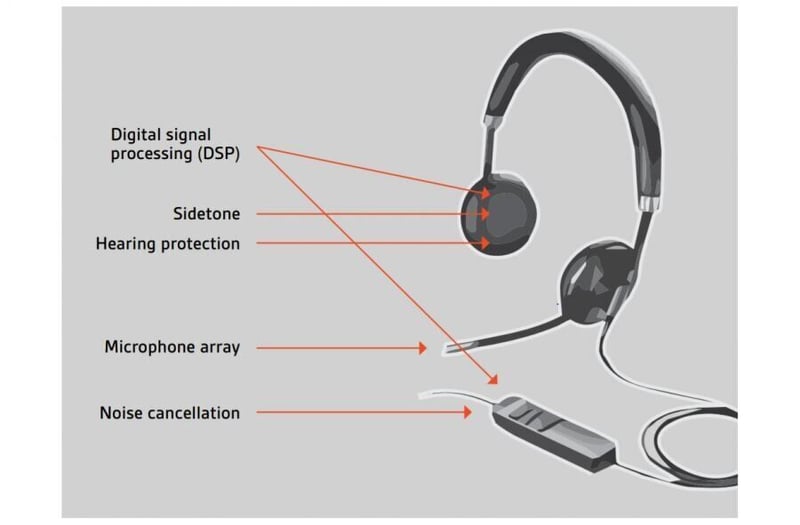What does it take to hear and be heard in the workplace?
Written by: KASYA Save to Instapaper
Approximately 15% of the world’s population has some degree of hearing loss, as recognized by the World Health Organisation, WHO. In Sub-Saharan Africa, slight impairment (defined a 26-40 dB) tracked at just over 14% (1). Fostering a corporate climate which promotes the inclusion of differently-abled workers into the workplace, which can include the right environment and equipment to support workers considered hard of hearing, is not only a compliance requirement in many countries across the world, but in some circumstances can also help to improve productivity.
Noise has always had the potential to distract people from the task at hand. Today, changes in the workplace have introduced new levels of noise that were absent just a few years ago. Effective noise management is now a business imperative that extends from inside the office walls to anywhere work happens.
Noise management in the office begins with acoustics. The first step is to look over the workplace to determine what can be done acoustically to improve the environment. Consider where different groups of workers are located, and assess whether each group’s communications needs are helped or hindered by their specific location. Where noise is a problem, the following best practices has the potential to enhance acoustic performance, whatever the office environment:
Best Practices to Consider:
- Specialized materials on floors, walls and ceilings minimize noise. For example, covering bare floors with carpeting is an essential step for reducing noise.
- Vertical barriers limit sound travel across an open-plan office. Consider placing divider panels between affected areas.
- Computer-generated sounds mask unwanted noise. Many companies pipe in background noise, or allow people to listen to music to block sound.
- Introduce headsets to block out background noise wherever it occurs and help users enjoy higher quality communications.
Plantronics headset technologies build on the noise protection provided by other acoustic best practices and our headsets are backed by extensive development and testing facilities, plus over 50 years of audio engineering experience. The Plantronics range offers a variety of headset technologies, including:
- Noise cancellation: Plantronics achieves optimum results using active and passive noise cancellation at both the transmission point (what you hear) and reception point (how you sound).
- Digital signal processing (DSP): DSP in Plantronics headsets produces a more natural voice sound by applying specialized algorithms to digitized voice signals.
- Sidetone: This feature provides out-of-band feedback in real time to let people know how they sound to the listener or listeners on a call.
- Microphone array: Using multiple microphones in a single device delivers exceptional sound clarity.
- Hearing protection: Plantronics SoundGuard technology helps to ensure that loud tones are quickly reduced to more comfortable levels, using a sophisticated three-stage process to protect users from sudden increases in sound levels.
Current industry trends are driving the need for improved noise management. Covering calls from desk phones, PCs and mobile devices, Plantronics offers a range of corded and wireless audio solutions that enhance the audio experience for business customers. To find out more about different solutions available in South Africa, please get in touch with a local authorized distributor at www.plantronics.com/za
Plantronics is an audio pioneer and a global leader in the communications industry. We create intelligent and adaptive solutions that support our customers’ most important needs: experiencing and facilitating simple and clear communications while enjoying distraction-free environments. Our solutions are used worldwide by consumers and businesses alike, and are an optimal choice for open office environments. From Unified Communications and customer service ecosystems, to data analytics and Bluetooth headsets, Plantronics delivers high-quality communications solutions that our customers count on today, while relentlessly innovating on behalf of their future. For more information visit www.plantronics.com/za
© 2018 Plantronics, Inc. All trademarks are the property of their respective owners.
(1) MBD, WHO, 2011 DHL estimates as reported within, WHO global estimates on prevalence of hearing loss Mortality and Burden of Diseases and Prevention of Blindness and Deafness, WHO, 2012
Get new press articles by email
Latest from
- KEEPING EMPLOYEES ENGAGED STRENGTHENS AN ORGANIZATION
- Nectar UC Diagnostics Works with Plantronics Manager Pro SaaS Offering to Improve UC Experience
- 64% of employees agree blocking out noise increases their productivity
- A New Global Study Finds The Noise Epidemic Worsening At Work, With Employees In Noisy Offices More Likely To Leave Their Job Within Six Months
- NEW RIG 500 PRO SERIES DELIVERS GAME-CHANGING AUDIO AT YOUR FINGERTIPS
- Even Small Meeting Rooms Deserve Large-Scale Performance
- Today’s CSRs are under pressure to do a lot more for customers. Is your IT department equipped to deliver what they need?
- Plantronics Backbeat Go 600 Wireless Headphones - Superior And Personalized Sound For Less
- Try it once and you’ll be hooked for life - Active Noise Cancelling
- PLANTRONICS MANAGER PRO V3.11 EXPANDS HEADSET INSIGHT AND MANAGEMENT TO IOS AND ANDROID DEVICES
- Managing Noise in the Modern Workplace
- Plantronics Backbeat FIT Series for active fitness, available in South Africa
- Plantronics Tech Tip - Active and Passive Noise Canceling
- Help your customers understand why workplace noise affects productivity and profitability. And how they can fix it.
- Plantronics introduces its first Bluetooth Neckband Headset with Earbuds - Voyager 6200 UC
The Pulse Latest Articles
- Education Is The Frontline Of Inequality, Business Must Show Up (December 11, 2025)
- When The Purple Profile Pictures Fade, The Real Work Begins (December 11, 2025)
- Dear Santa, Please Skip The Socks This Year (December 10, 2025)
- Brandtech+ Has 100 Global Creative Roles For South African Talent (December 9, 2025)
- The Woman Behind Bertie: Michelle’s Journey To Cape Town’s Beloved Mobile Café (December 9, 2025)
